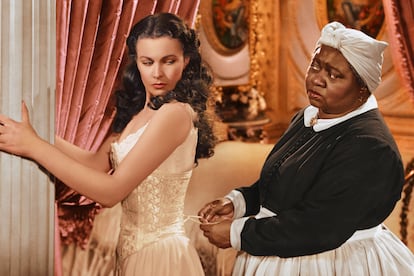The secret history of ‘Gone with the Wind’: A script documents the racial tensions that flared while filming
The original script for the 1939 classic reveals the clashes that took place between those who defended a romanticized vision of the South – based on the original novel – and those who advocated for a realistic portrait of the horrors of slavery


For a few days in June 2020, HBO Max removed Gone with the Wind from its platform. The 1939 classic film was temporarily embattled, due to rising racial tensions in the United States. The entertainment giant acknowledged that the blockbuster movie glorified the slave-owning past of the US and avoided criticism of the segregation imposed on African Americans in the South. The film – directed by Victor Fleming (as well as George Cukor and Sam Wood, who were never credited) – was subsequently made available a few days after the removal, but this time with an introductory message that provided some historical context. In today’s digital age, such clarifications often accompany cinematic productions from past eras.
A copy of the script used during the filming has recently shed light on the clashes related to slavery that took place within the production team, led by the legendary David O. Selznick. David Vincent Kimel, a historian at Yale, emphasized that the script – which includes several scenes that were later edited – indicates that a form of “civil war” took place between the producer, a dozen screenwriters (among whom was F. Scott Fitzgerald), the Black cast members and various organizations against racism.
Between these blocs, there was a tug of war with two opposing positions: on the one hand, there were those who considered it necessary to realistically portray the harshness of slavery. On the other were those who preferred to stick to what the writer, Margaret Mitchell, had conveyed in the novel that served as the basis for the film. Gone with the Wind would go on to win eight Oscars. This included the first Academy Award for an African-American actress, Hattie McDaniel, who was recognized in the category of Best Supporting Actress.

Kimel happened to find the script in a bookstore on the Internet and bought it for $15,000. It is a rare script of 301 colored pages that was used during the filming, which lasted several months in 1939. Several such scripts were used, christened rainbow scripts because of the colored sheets that indicated to the technical crew the changes that were made to the story. According to Kimel, the one he purchased belonged to casting director Fred Schuessler and has been authenticated by Bonhams auction house. It is an almost unique document. Miraculously, only a handful survived Selznick’s order to destroy them.
Kimel noted that some of the deleted scenes were filmed, according to photographs taken during filming. This material would eventually come out in the final footage in one of the later editions. One of the deleted scenes shows Rhett Butler – the character played by Clark Gable – sitting in front of a bottle of whiskey and stroking a firearm, considering a possible suicide. Suddenly, someone knocks on the door and distracts him from his thoughts. He hides the pistol in one of his riding boots and stands up abruptly, revealing that he is quite drunk.
In another sequence, which was later cut, riots are shown in Atlanta, the Georgia city where the action of the film, set during the Civil War, takes place. The camera movement showed Butler on horseback moving through a destroyed city. The animal stopped amidst the chaos. There were men and women looting stores and carrying the goods they had taken from the businesses. “Everything has an atmosphere of disorder and drunkenness, a city descending into chaos as it nears its end,” reads the script, which also includes a cross-dressing man running in front of a wagon carrying dresses.
Most of the settings reflected in Schuessler’s script are on the plantation owned by Scarlet O’Hara, the female character played by Vivien Leigh. Selznick asked to cut out some details that might have shown more realistically how Black people were treated in the slave-owning South. Ultimately, references to brutal beatings, the threat to fire Mammy (Hattie McDaniel) for being lazy, as well as other displays of physical and emotional violence were left out of the final script.
To understand what led the legendary producer, himself a Jew who fought against rampant anti-Semitism in Los Angeles, to dispense with this material, David Vincent Kimel turned to the filmmaker’s notes at the Harry Ransom Center in Texas. The center’s archive reflects that Selznick was concerned not only with the pace and quality of the dialogue, but also with sticking as closely as possible to the novel, which was published in 1936.
In a correspondence with Val Lewton – one of the writers who participated in the writing of the script – the producer regrets not being able to use the slur “ni****. “Maybe it’s not too late to use it two or three times,” Selznick tells Lewton, who asks him to research whether using that word – which appears in the novel – would result in them violating any censorship laws. Lewton replies that it’s best to avoid the slur, because it creates too many problems.
The researcher points out, however, that Selznick never wanted to make a racist film and that he was always “very careful” that his team portrayed African-Americans in the best possible light. Despite its fidelity to the source material, the production never had much help from the author, Margaret Mitchell, who won the Pulitzer Prize for the book.
The producer ended up on several occasions eliminating dialogues, rewriting parliaments or diluting the tone in some of the scenes. The rainbow script shows a downgraded version of a scene where the charismatic Scarlet O’Hara threatens to sell Prissy, one of her maids. Selznick also deleted a scene where Prissy is pinched and asked to shut up. But he also omitted an opening that would have glorified the Southern slave army and a first frame that would have shown the Confederate flag.
The documents that are kept in the Harry Ransom center also mention another Hollywood legend: F. Scott Fitzgerald, who arrived at the chaotic shoot following the firing of two directors and several writers. Fitzgerald arrived in Los Angeles in 1937, when the fame generated by the publication of The Great Gatsby – which hit bookstores in 1925 – was already far in the rearview mirror. Bitter and struggling with alcohol problems, Selznick hired him to replace two screenwriters, Sidney Howard (who kept the final credit) and Oliver Garrett.
The writer found that he could only use the words of Margaret Mitchell as sculpting material. One of his few suggestions was an outburst depicting life in the Old South. He was fired and along came the legendary Ben Hecht, famous in Hollywood for channeling stories that went nowhere. Fitzgerald died in 1940 drunk in a gray West Hollywood apartment. But Gone with the Wind continues to provoke debate 84 years later.
Sign up for our weekly newsletter to get more English-language news coverage from EL PAÍS USA Edition
Tu suscripción se está usando en otro dispositivo
¿Quieres añadir otro usuario a tu suscripción?
Si continúas leyendo en este dispositivo, no se podrá leer en el otro.
FlechaTu suscripción se está usando en otro dispositivo y solo puedes acceder a EL PAÍS desde un dispositivo a la vez.
Si quieres compartir tu cuenta, cambia tu suscripción a la modalidad Premium, así podrás añadir otro usuario. Cada uno accederá con su propia cuenta de email, lo que os permitirá personalizar vuestra experiencia en EL PAÍS.
¿Tienes una suscripción de empresa? Accede aquí para contratar más cuentas.
En el caso de no saber quién está usando tu cuenta, te recomendamos cambiar tu contraseña aquí.
Si decides continuar compartiendo tu cuenta, este mensaje se mostrará en tu dispositivo y en el de la otra persona que está usando tu cuenta de forma indefinida, afectando a tu experiencia de lectura. Puedes consultar aquí los términos y condiciones de la suscripción digital.
More information
Archived In
Últimas noticias
ICE raids trigger school absenteeism and traumatize children: ‘They have been forced to leave their childhood behind’
Mexico’s missing people crisis casts a shadow over World Cup venue
Families demand repatriation of bodies of Colombians who died in Ukraine: ‘This war is a slaughterhouse for foreigners’
James Cameron: ‘For the films I like to make to continue to exist, we have to find a way to make them cheaper’
Most viewed
- Christian Louboutin: ‘Young people don’t want to be like their parents. And if their parents wear sneakers, they’re going to look for something else’
- US sanctions against jailed cartel leader ‘El Marro’ highlight Mexico’s lack of control over its prisons
- Cartels in Mexico take a leap forward with narco-drones: ‘It is criminal groups that are leading the innovation race’
- Liset Menéndez de la Prida, neuroscientist: ‘It’s not normal to constantly seek pleasure; it’s important to be bored, to be calm’
- ‘El Limones’ and the growing union disguise of Mexican organized crime










































